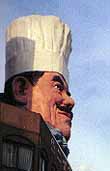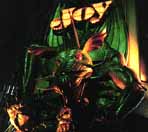November 6 Ikebukuro
Ikebukuro and Kappabashi (and how to eat sushi)
In the morning, wandering around Ikebukuro, engaged
in a fruitless search for a laundromat. I've seen
'em around, was hoping to located a small apartment
building's laundry room for quick access to the
coin-operated machines, but of course when I actually
need to use one, I found nothing. Back to
the hotel for some Euro-trip-style sink washing.
After a brief foray into Akihabara, where I got
a couple "greatest hits" CDs by 1960s pop artists
whom I'm sure won't see any percentage of my
purchase price, had lunch at Nippori. This was
at a third floor restaurant, where my seat was
next to a television showing golfers. Afterwards,
took a pedestrian overpass across the train tracks
and found myself in the Shitamachi neighborhood
I'd visited previously, approached
from an alternate direction.
Eventually I went over to Ueno, to pass through
the religious-goods and kitchenware areas en route
 to the Kaminarimon Gate in Asakusa. (The latter is
a traditional Tokyo
tourist
stop to which I'd return in a couple days.) Kappabashi
is the area known for its concentration
of kitchen and restaurant supply stores, marked
by the big chef's head at the beginning of the street.
Many visitors to Japan wonder where they can get
some of that model food, the shokuhin sanpuru
displayed outside restaurants - this is the
place (but that stuff isn't cheap). My mission there
was to locate a requested Christmas gift, a personal
bento box; as I figured, stores devoted entirely to
these could be found along this street. I examined the
stock: many of the rectangular kind were available,
with their little compartments; also the square stacking
kind (like I'd seen Yuko take to work Monday
morning) but I was most intrigued by a hexagonal
version, so that's what I got.
to the Kaminarimon Gate in Asakusa. (The latter is
a traditional Tokyo
tourist
stop to which I'd return in a couple days.) Kappabashi
is the area known for its concentration
of kitchen and restaurant supply stores, marked
by the big chef's head at the beginning of the street.
Many visitors to Japan wonder where they can get
some of that model food, the shokuhin sanpuru
displayed outside restaurants - this is the
place (but that stuff isn't cheap). My mission there
was to locate a requested Christmas gift, a personal
bento box; as I figured, stores devoted entirely to
these could be found along this street. I examined the
stock: many of the rectangular kind were available,
with their little compartments; also the square stacking
kind (like I'd seen Yuko take to work Monday
morning) but I was most intrigued by a hexagonal
version, so that's what I got.
Later, back near the hotel, had a
 wonderful revolving sushi
meal - I found the place near this dragon, whose
head moved back & forth. There was a two-stage
line to get in, so popular was this restaurant - first
we stood outside, then moved inside to sit along the
wall, on a bench. Finally a seat was available, and
it was at this specific point that I began using the
hashi (chopsticks). Of course I'd been eating
with them all along, but my usual attitude towards
sushi is it's finger food. The literature says using
your fingers is acceptable; after all, the chef just
prepared it with his bare hands, and I've followed
suit with gusto;*
but after observing the natives, the conclusion
had been reached that since the Japanese use their
hashi in the sushi bar, I should too. (The result
is, instead of stretching each nigiri into two
or three bites, now they're always just one big
mouthful.) Had my first taste of the shrimp-like
shako here, and unlike most kaiten
sushi bars, where the color-coded plates are
priced differently, they had a mono-price policy here,
the adjustment made by varying portion size (for
example, dishes of less expensive fish might have
not two but three nigiris; on the other hand,
the unagi eel came as just
one (large) piece.)
wonderful revolving sushi
meal - I found the place near this dragon, whose
head moved back & forth. There was a two-stage
line to get in, so popular was this restaurant - first
we stood outside, then moved inside to sit along the
wall, on a bench. Finally a seat was available, and
it was at this specific point that I began using the
hashi (chopsticks). Of course I'd been eating
with them all along, but my usual attitude towards
sushi is it's finger food. The literature says using
your fingers is acceptable; after all, the chef just
prepared it with his bare hands, and I've followed
suit with gusto;*
but after observing the natives, the conclusion
had been reached that since the Japanese use their
hashi in the sushi bar, I should too. (The result
is, instead of stretching each nigiri into two
or three bites, now they're always just one big
mouthful.) Had my first taste of the shrimp-like
shako here, and unlike most kaiten
sushi bars, where the color-coded plates are
priced differently, they had a mono-price policy here,
the adjustment made by varying portion size (for
example, dishes of less expensive fish might have
not two but three nigiris; on the other hand,
the unagi eel came as just
one (large) piece.)
Afterwards, several evening hours riding around and
around on the Yamanote, searching for the best sonic
opportunities to capture, carrying around my little
recorder again, filling up the rest of the tape. Something
was amiss with the system because twice the train I was
on was taken out of service, and a lot of additional rail
personnel were around, on the platforms, doing things
manually, it seemed: they had little lanterns with bright
white lamps (perhaps mini-halogen or even xenon bulbs)
which they were using to signal.
Note:
* Of course there's exceptions:
I deploy my hashi to extract the seaweed
and chunks of tofu from the miso
soup, and to transfer the gari ginger as
well as those little tekka-maki
cylinders into my mouth; but I've observed way
too many pseudo-worldly yuppies awkwardly
grappling with the larger nigiri sushies,
and dropping the whole thing as it messily
falls apart - there's no desire to resemble
them.
Back
|


